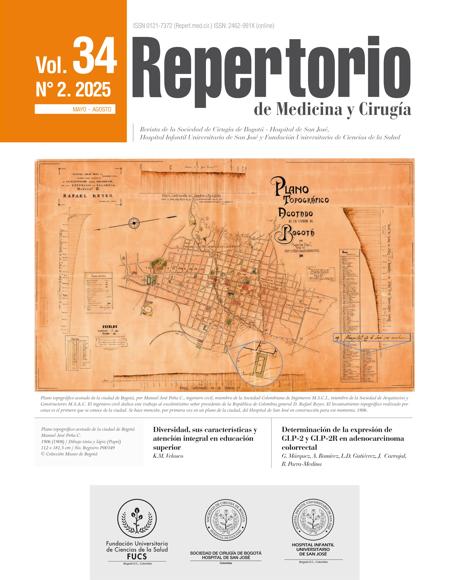Síndrome de Wolf-Hirschhorn: variante de localización cromosómica clásica, primer caso reportado en población pediátrica colombiana
Wolf-hirschhorn syndrome: a classical chromosomal localization variant: first case reported in the Colombian pediatric population
Cómo citar
Descargar cita
Esta obra está bajo una licencia internacional Creative Commons Atribución-NoComercial-CompartirIgual 4.0.
Mostrar biografía de los autores
Introducción: el síndrome de Wolf-Hirschhorn (SWH) (OMIM: #194190-ORFA: 280) es una afección genética poco frecuente, caracterizada por la deleción parcial y distal del brazo corto del cromosoma 4. Los rasgos faciales dismórficos, el retraso del neurodesarrollo y el compromiso cardiovascular, genitourinario y osteomuscular, forman parte del espectro clínico. Presentación del caso: paciente de 10 años de edad con antecedente de glaucoma congénito bilateral con oculoplastia ya realizada, luxación bilateral de cadera, retraso en el neurodesarrollo y baja talla sindromática con dismorfismo facial típico en “guerrero griego”, por lo que se sospechó SWH. Se solicitó la realización de array de hibridación genómica en el cual se destaca deleción del cromosoma 4 en localización cromosómica 15.33, con coordenadas genómicas 11881248- 12219794 compatible con SWH. Discusión: teniendo en cuenta la localización cromosómica típica del SWH, se encontró en la literatura la posibilidad del mismo en localizaciones diferentes, relacionadas con aumento del espectro clínico como se evidencia en nuestro paciente. Conclusiones: la detección temprana de los casos con un cuadro clínico compatible con SWH, ha demostrado utilidad para la implementación temprana del perfil del panel de estudios genéticos disponibles en la actualidad y el impacto en la calidad de vida de los pacientes, secundario a intervenciones tempranas.
Visitas del artículo 1147 | Visitas PDF 530
Descargas
- Battaglia A, Carey JC. The delineation of the Wolf-Hirschhorn syndrome over six decades: Illustration of the ongoing advances in phenotype analysis and cytogenomic technology. Am J Med Genet A. 2021;185(9):2748–55. https://doi.org/10.1002/ajmg.a.62341.
- Gavril EC, Luca AC, Curpan AS, Popescu R, Resmerita I, Panzaru MC, et al. Wolf-Hirschhorn Syndrome: Clinical and Genetic Study of 7 New Cases, and Mini Review. Children. 2021;8(9):751. https://doi.org/10.3390/children8090751.
- Mbuyi-Musanzayi S, Lumaka A, Kasole T, Ilunga E, Asani B, Tshilobo P, et al. Wolf-Hirschhorn Syndrome: Clinical and Genetic Data from a First Case Diagnosed in Central Africa. J Pediatr Genet. 2017;6(3):186–90. https://doi.org/10.1055/s-0037-1599194.
- Buddhdev PK, Sabir A, Kokkinakis M, Irving M, Norman‐Taylor F. Hip displacement in WOLF–HIRSCHHORN syndrome: Report on three cases and review of associated musculoskeletal pathologies. Am J Med Genet A. 2020;182(6):1449–53. https://doi.org/10.1002/ajmg.a.61573.
- Zorlu P, Eksioglu AS, Ozkan M, Tos T, Senel S. A rare subtelomeric deletion syndrome: Wolf Hirschhorn syndrome. Genet Couns. 2014;25(3):299–303.
- Nevado J, Ho KS, Zollino M, Blanco R, Cobaleda C, Golzio C, et al. International meeting on Wolf-Hirschhorn syndrome: Update on the nosology and new insights on the pathogenic mechanisms for seizures and growth delay. Am J Med Genet A. 2020;182(1):257–267. https://doi.org/10.1002/ajmg.a.61406.
- Siew JX, Yap F. Growth trajectory and pubertal tempo from birth till final height in a girl with Wolf-Hirschhorn syndrome. Endocrinol Diabetes Metab Case Rep. 2018;2018:18-0001. https://doi.org/10.1530/EDM-18-0001.
- Xia C, Kumar D, You B, Streck DL, Osborne L, Dermody J, et al. Wolf-Hirschhorn Syndrome with Hyperparathyroidism: A Case Report and a Narrative Review of the Literature. J Pediatr Genet. 2021;(2). https://doi.org/10.1055/s-0041-1729751.
- Battaglia A, Carey JC, South ST. Wolf-Hirschhorn syndrome: A review and update. Am J Med Genet C Semin Med Genet. 2015;169(3):216–23. https://doi.org/10.1002/ajmg.c.31449.













